|
July 25, 2018
In the Spring of 2009, when we first met Rufous Hawk, we had no idea that he was beginning a "Saga" in the surrounds of our neighborhood. Unfortunately, we have no photos of him until 2010, when we realized he was here to stay. On this page, you can see the changes in him from year to year. Most of the photos we have of Rufous were taken in early spring, when he was thinking about courting his mate. Later on, we have very few photos of him, because he was secretively hunting and guarding his nest.
Let me begin by saying, the Cooper's hawks we have observed were not banded, so we have no way of proving they are the same hawks from one year to the next, or even within the same season. Also, photographs of the same hawk, as we watch it moving about in the tree, make the hawk look very different. Cloudy skies can make the eyes appear dark, while direct sunlight makes them appear bright. The hawk may have a full crop and appear to be "fat." The hawk may have fluffed-out feathers because he is grooming, rousing, or cold. So, with these caveats, we must admit to speculation. Our thoughts are guided by the hawks' (1) habits, (2) general appearance, and (3) disposition.
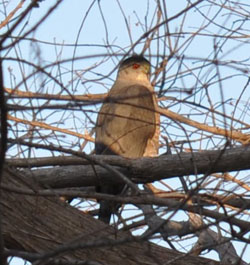
Year 2010
| 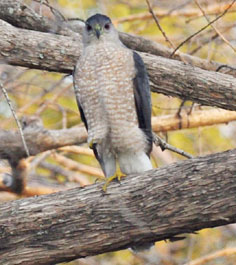
Year 2011
|
|
A male Cooper's hawk begins breeding when he is 2+ years old, and Rufous was likely in his first year as a mature hawk when he chose our neighborhood in Valley Ranch as his territory. The rufous tint of his cheek and his bright red eyes suggest that he is a young hawk.
|
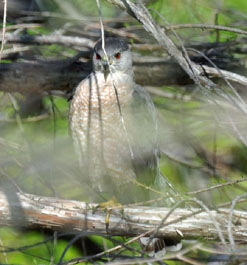
Year 2012
| 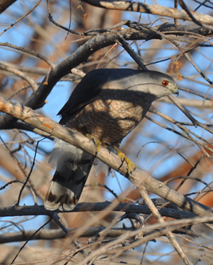
Year 2013
|
|
Rufous continues to return to his territory in Valley Ranch. Although he has chosen several different trees for his nest over time, the locations are within a few yards of each other, and always in a live oak tree. He and his mate, Henrietta, choose the same trees each year for mating and prey preparation. Rufous is now in his prime, with deep red but still bright eyes and a cheek that still has a rosy hue.
|

Year 2014
| 
Year 2015
|
|
In year 2014, Rufous brought a new female to his territory. We named her Roxie, and she would be a mother to Rufous' chicks for three consecutive years in the same nest. You can see that Rufous' cheeks have begun to lighten considerably, and his eyes have deepened in color.
|
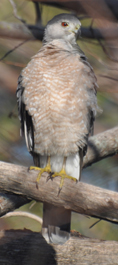
Year 2016
| 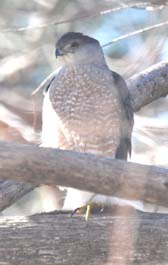
Year 2017
|
|
Rufous' cheeks have become white, almost all the way to his nape. His eyes are now a deep garnet and there is a distinct droop of his eyelids. Poor old fellow... he looks tired. And well he might be! Assuming this is the same male hawk that we believe it to be, he is now in his tenth or eleventh year. The upper reach of life span expected for a male Cooper's hawk in the wild is 12 years, and the average life span is only 1.3 years! So it was no surprise when a different male hawk showed up in 2018. The new hawk (R2D2) was reluctant to come to the same cypress tree where Rufous always hung out. Despite different behavior in this regard, he chose to nest in the same live oak tree where Rufous' nest was located in the first season. (Perhaps Roxie had a say about that!)
We will miss Rufous! He taught us so much about hawks and life in the wild. Thank you, Rufous, for sharing your life with us humans. Perhaps we'll meet again one day beyond the Rainbow Bridge.
|
Continue to [TABLE OF CONTENTS]
|